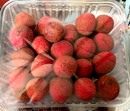An evergreen tree reaching 10–28 metres tall, the lychee bears fleshy fruits that are up to 5 cm (2.0 in) long and 4 cm (1.6 in) wide. The outside of the fruit is covered by a pink-red, roughly textured rind that is inedible but easily removed to expose a layer of sweet, translucent white flesh. Lychees are eaten in many different dessert dishes, and are especially popular in China, throughout Southeast Asia, along with South Asia and parts of Southern Africa.
The lychee is cultivated in China, Sri Lanka, Taiwan, Thailand, Vietnam, Japan, India, Bangladesh, Pakistan, Nepal, Australia, Mexico and parts of Southern Africa. China is the main producer, followed by India.
The lychee has a history and cultivation going back to 2000 BC according to records in China. Cultivation began in the area of southern China, Malaysia, and Vietnam. Wild trees still grow in parts of southern China and on Hainan Island. There are many stories of the fruit's use as a delicacy in the Chinese Imperial Court. It was first described and introduced to the West in 1656 by Michael Boym, a Polish Jesuit missionary (at that time Polish–Lithuanian Commonwealth).(quote from wikipedia)









